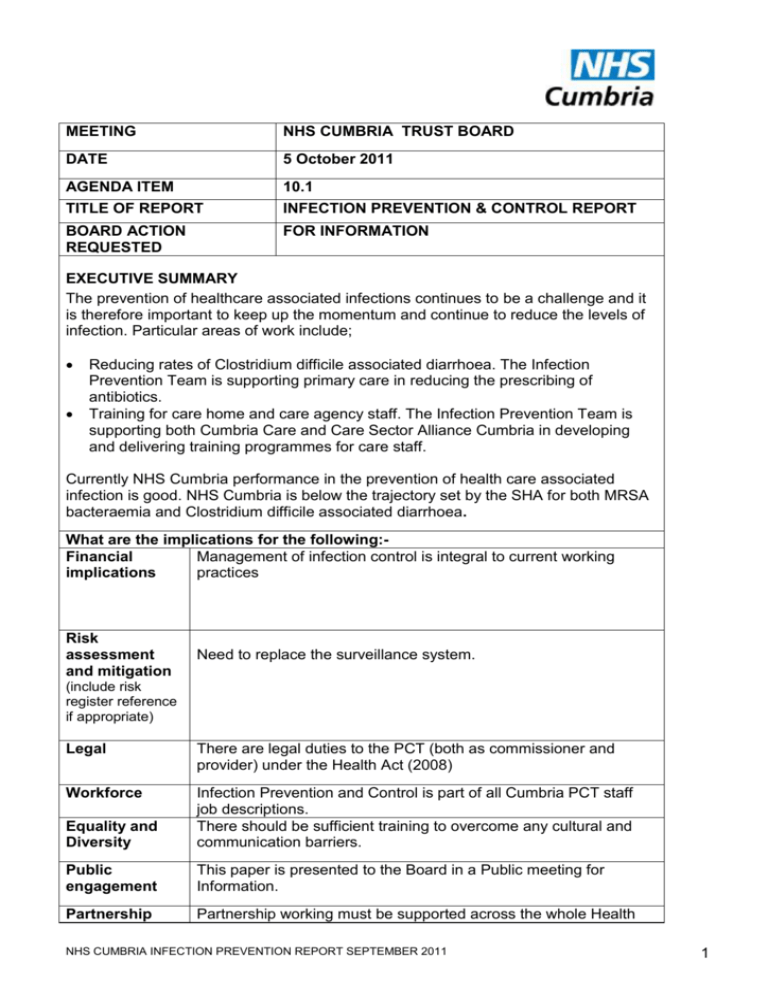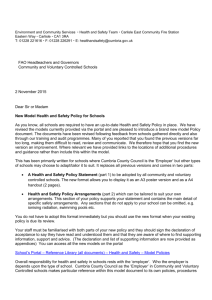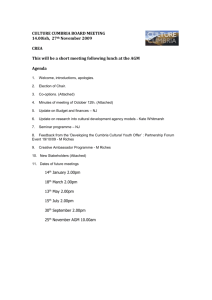NHS Cumbria Infection Control Report Sept 2011
advertisement

MEETING NHS CUMBRIA TRUST BOARD DATE 5 October 2011 AGENDA ITEM 10.1 TITLE OF REPORT INFECTION PREVENTION & CONTROL REPORT BOARD ACTION REQUESTED FOR INFORMATION EXECUTIVE SUMMARY The prevention of healthcare associated infections continues to be a challenge and it is therefore important to keep up the momentum and continue to reduce the levels of infection. Particular areas of work include; Reducing rates of Clostridium difficile associated diarrhoea. The Infection Prevention Team is supporting primary care in reducing the prescribing of antibiotics. Training for care home and care agency staff. The Infection Prevention Team is supporting both Cumbria Care and Care Sector Alliance Cumbria in developing and delivering training programmes for care staff. Currently NHS Cumbria performance in the prevention of health care associated infection is good. NHS Cumbria is below the trajectory set by the SHA for both MRSA bacteraemia and Clostridium difficile associated diarrhoea. What are the implications for the following:Financial Management of infection control is integral to current working implications practices Risk assessment and mitigation Need to replace the surveillance system. (include risk register reference if appropriate) Legal There are legal duties to the PCT (both as commissioner and provider) under the Health Act (2008) Workforce Equality and Diversity Infection Prevention and Control is part of all Cumbria PCT staff job descriptions. There should be sufficient training to overcome any cultural and communication barriers. Public engagement This paper is presented to the Board in a Public meeting for Information. Partnership Partnership working must be supported across the whole Health NHS CUMBRIA INFECTION PREVENTION REPORT SEPTEMBER 2011 1 Economy in Cumbria and close links between commissioners, providers and the Health Protection Agency must be fostered Communication This report will be publicised on the PCTs website State where this paper has been discussed or agreed prior to the Trust Board i.e. committees etc This paper has been prepared by PCT and Acute Trust staff. What are the next steps? The recommendations in this paper will be taken forward through Cumbria Infection Prevention Steering Group Public Engagement Matrix Level Evidence Please Tick () as appropriate Information Giving Sharing of information in order to increase awareness Consultation People’s views and/or experience sought and taken into account Community Involvement Mechanisms in place in order to secure lay participation Capacity Building Skills/knowledge/ resources being transferred to support community or condition groups etc Empowerment Partnership or other agreement with accountability transfer Which Cumbria PCT objective does this paper support? Insert Tick () To work with others to improve health for the people of Cumbria To make best use of all available resources To achieve core standards and targets Reference or Standard number, eg, Standards for Better Health Core Standard – Infection Control (if appropriate) Core standard – infection control Director Sponsor Prof John Ashton, Director of Public Health Presented By Dr Nigel Calvert, Associate Director of Public Health Dr Nigel Calvert nigel.calvert@cumbriapct.nhs.uk Contact Details NHS CUMBRIA INFECTION PREVENTION REPORT SEPTEMBER 2011 2 Infection Report Prevention and Control September 2011 NHS CUMBRIA INFECTION PREVENTION REPORT SEPTEMBER 2011 3 Introduction This report aims to inform NHS Cumbria Board of current issues in infection prevention and control and to report on progress for the period June – August 2011. NHS Cumbria has a key role in implementing and monitoring improvements in infection prevention and control across Cumbria as its role is to: Commission services from healthcare providers for its local population. Commission general medical services: including General Practices, NHS Dentists, Optometrists and Community Pharmacists. This report covers services commissioned by the PCT. HEALTH PROTECTION – INFECTION PREVENTION & CONTROL TEAM NHS Cumbria Infection Prevention and Control function sits within Health Protection in Public Health. The Government’s publication Healthy Lives, Healthy People: our strategy for public health in England sets out the transfer of public health to Local Authorities, as it stands this includes the local Health Protection Team incorporating infection prevention and control. The Team is as follows: Associate Director of Public Health – Health Protection 0.8 Senior Health Protection Nurse 0.8 Health Protection Nurse Intelligence Surveillance Clostridium difficile associated diarrhoea (CDAD) NHS Cumbria is below the trajectory set by the Strategic Health Authority (SHA) for the number of cases of CDAD. However, in June 31 patients were reported as suffering CDAD. This caused concern as we would need to go back to March 2010 to see more cases reported in a one month period. The cases in June were broken down as follows: 7 apportioned to UHMBT (Cumbria residents); 7 apportioned to NCUHT; 1 apportioned Blackpool (Cumbria resident) 16 apportioned as GP/pre 48 hour (1Cumb Partnership) NHS CUMBRIA INFECTION PREVENTION REPORT SEPTEMBER 2011 4 The following information is a summary of the issues & the actions that have been put in place. GP/pre 48 hour cases The data collected following each report showed that patients had either had a recent stay in hospital or had been prescribed antibiotics appropriately. 2 patients were seen by the same GP; however, one of these patients was not prescribed antibiotics. The Associate Director of Public Health – Health Protection and a Consultant Microbiologist visited this GP to discuss antibiotic prescribing. 4 other practices have been visited by the same professionals to discuss antibiotic prescribing. Training has also been arranged to take place during practices Protected Learning Time. The increase in community cases may be linked to the periods of increased incidence * at the acute trusts as detailed below. University Hospital of Morecambe Bay NHS Trust (UHMBT) A Norovirus outbreak (OB) at Furness General Hospital (FGH) UHMBT during June resulted in some increased testing, but this did not explain all of the increased in case numbers. There were 6 reports of CDAD at FGH and 1 case at Westmorland General Hospital (WGH). No new emerging themes were found from the collection of data. A period of increased incidence* investigation was undertaken at FGH. A ward that has increased isolation occupancy is available to care for patients suffering CDAD at FGH. North Cumbria University Hospitals NHS Trust (NUCHT) Periods of increased incidence* were declared on 3 wards on the Carlisle site. Actions included: a deep clean of the affected wards and a major redesign on one ward which is ongoing to remedy some of the issues identified. *A period of increased incidence (PII) of CDAD: two or more new cases (occurring more than 48 hours post admission, not relapses) in a 28-day period on a ward. (DH 2009 clostridium difficile infection: How to deal with the problem) The number of patients reported as suffering the infection in July fell to 16. MRSA Bacteraemia The SHA trajectory for Cumbria for 2011 – 2012 is 12. Up to the end of July 4 patients have been reported as suffering a MRSA bacteraemia. Root cause analyses have been conducted. All of these patients’ infections with the exception of one were apportioned to care in the community. Two patients received community nursing care in their own home and one patient lived in a care home. The fourth patient’s report was apportioned to UHMBT but following a root cause analysis was agreed to be as a result of a contaminated sample in that the patient was not suffering MRSA bacteraemia. Extension of surveillance As from January 2011 there is a mandatory requirement for all NHS acute trusts to report Meticillin Sensitive Staphylococcus aureus (MSSA) bacteraemia. Mandatory surveillance was also extended to E. coli bloodstream infections from 1 June 2011. This extension reflects the zero tolerance approach that the Government have made clear that the NHS should adopt for NHS CUMBRIA INFECTION PREVENTION REPORT SEPTEMBER 2011 5 all Healthcare Associated Infections (HCAIs), while recognising that not all MSSA bacteraemia are HCAIs. In terms of expectations over the remainder of 2011-12, with MSSA and E.coli bloodstream infections, the Department of Health requests that commissioners, providers and those involved in performance management, focus initially on ensuring comprehensive compliance with this extension of mandatory surveillance. Once the mandatory data reporting has been embedded and there is a robust baseline established on those E. coli infections and MSSAs that are healthcare associated, the Department of Health have stated that organisations will wish to consider what additional interventions could be introduced to minimise these infections. Wider Measures Cumbria Infection Prevention Steering Group The first meeting of the Cumbria Infection Prevention Steering Group took place in June. The aim of this Group is to ensure that sustained, reduced rates of Health-care associated infection (HCAI) are evident across the whole health economy by implementing measures that are known to be effective. The objectives of the Group include: Strategic direction Advice & support Overview of HCAIs Work projects Those with roles in Infection Prevention including: Directors if Infection prevention and Control; specialist nurses, microbiologists and pharmacists from the three Cumbria NHS Trusts are members of the Group, along side GPs, representatives from the Health Protection Agency and Cumbria County Council Adult Social Care. The Care Quality Commission (CQC) also has a role in this Group and CQC representatives will be attending the next meeting. Care homes and care agencies The Team continues to link with Cumbria County Council by way of both Cumbria Care (CC) and Care Sector Alliance Cumbria (CSAC) with regard to training and support. CSAC arranged 4 half day infection prevention training sessions across the county. The Infection Prevention Team delivered the training. 38 organisations were represented and 78 carers attended. We will be delivering training sessions with Cumbria Care for that organisation’s Infection Prevention Link Workers in the autumn. . A self assessment audit tool was distributed to all care homes in Cumbria. The aim of this audit was to assist Nursing and Residential Care Home establishments to identify good, acceptable and poor aspects of their environment and practice in the context of infection prevention and control. A further aim was to inform future training and resource needs for their organisation and also to form part of their overall clinical governance. The closing date for return has passed but audits continue to be submitted. A response rate of more than 60% has been achieved so far. Results are being analysed and will be reported at a later date. NHS CUMBRIA INFECTION PREVENTION REPORT SEPTEMBER 2011 6 Current Picture of Healthcare-Associated Infection in Cumbria The graphs below show the number of MRSA bacteraemia infections and the number of Clostridium difficile infections that have been reported by North Cumbria University Trust (NCUHT) and University of Morecambe Bay NHS Trust (UHMBT). The last two graphs show total figures for MRSA bacteraemia and Clostridium difficile for the residents of Cumbria. North Cumbria University Hospitals NHS Trust (NCUHT) MRSA bacteraemia No MRSA bacteraemias have been apportioned to NCUHT. Clostridium difficile The graph below shows the number of cases apportioned to NCUHT CDiff Cases NCUHT 25 20 15 Actuals Trajectory 10 5 0 Apr-11 May-11 Jun-11 Jul-11 University Hospitals of Morecambe Bay NHS Trust (UHMBT) MRSA bacteraemia The graph below shows infections that have been reported by UHMBT laboratory. The graph shows the cases apportioned to the acute trust and also cases apportioned as non-acute, that is care they received in the community. (The figures below include patients resident in North Lancashire). NHS CUMBRIA INFECTION PREVENTION REPORT SEPTEMBER 2011 7 MRSA Cases Reported by UHMBT 3 2 1 0 Apr-10 May-10 Jun-10 Jul-10 Acute 0 2 0 0 Non-Acute 1 0 0 0 Aug-10 Sep-10 Oct-10 Nov-10 Dec-10 Jan-11 Feb-11 Mar-11 Clostridium difficile CDiff Case Reported by UHMBT (Cumulative) 25 20 15 Actuals Trajectory 10 5 0 Apr-11 May-11 Jun-11 Jul-11 NHS Cumbria The SHA trajectory for Cumbria for 2011 – 2012 is 12. Up to the end of July 4 patients have been reported as suffering a MRSA bacteraemia. All of these patients’ infections with the exception of one were apportioned to care in the community. NHS CUMBRIA INFECTION PREVENTION REPORT SEPTEMBER 2011 8 MRSA bacteraemia NHS Cumbria Commissioner MRSA 3 2 1 0 CPCT Apr-10 May-10 Jun-10 Jul-10 2 1 0 1 Aug-10 Sep-10 Oct-10 Nov-10 Dec-10 Jan-11 Feb-11 Mar-11 Clostridium difficile (The figs below include residents of Cumbria who suffered the infection out of the area of Cumbria i.e. in another PCT area). The trajectory set by the SHA for April 2012 – March 2013 is 243. PCO CDiff Infections Breakdown (Cumulative) 100 Not Set Other 80 Not Know n Penal Establishment 60 GP/Pre 48 Hour Residential Home 40 Nursing Home Private Hospital 20 CPFT (PCT Hospital) Acute Hospital 0 Apr-11 May-11 Jun-11 Jul-11 Conclusion This report has described the current situation with regard to healthcare associated infections up to the beginning of August. The report also describes work that is underway with the independent sector to facilitate a sustained reduction in infections. NHS CUMBRIA INFECTION PREVENTION REPORT SEPTEMBER 2011 9 As stated earlier, NHS Cumbria performance is good. NHS Cumbria is below the trajectory set by the SHA for both MRSA bacteraemia and Clostridium difficile associated diarrhoea. NHS CUMBRIA INFECTION PREVENTION REPORT SEPTEMBER 2011 10 TRUST BOARD 5 OCTOBER 2011 AGENDA ITEM: 10.1 Contact details: Name: Nigel Calvert Address: PCT HQ Tel: 07920467372 Email: nigel.calvert@cumbriapct.nhs.uk Web: 11 NHS Cumbria





